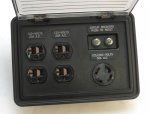Ok, here go a few points: The Mep-016d's are Vietnam era gasoline powered MEP-016a's and MEP-016c's that have been retrofitted with a 1 cylinder Yanmar L70 engine as a life extension program that started in the late 1990's, there is a lot of variation on the quality and components used in the conversions as some were converted by contractors and others by field units, so expect some variation from the book, some /most have starters (they do not have an onboard battery or complete charging systems though and are designed to be jump started with slave cables), some have original belly tanks, some have modern plastic belly tanks, etc..
In my case I have a MEP-701a (Onan diesel powered MEP-016b in an ASK) for standby power at my house, but also have a MEP-016d that I am setting up as a portable/loaner unit for relatives, spare, etc. In my case I have no 240V loads and run in in 120V only mode so as to get the full 3KW output power in a single connection leg, instead of 120/240V split phase mode (household 120/240) where I would have 2 legs of 120V each being half the output rating of the generator (2 legs of 1.5KW each for 120V loads). Note 120/240V mode is not officially supported by these generators, but some have had their wiring modified to support this type of operation (it is a simple extra jumper wire, but adding it must be done carefully as it is not compatible with the voltage reconnection switch (inside the box) in other positions). Balancing 2 legs of 1.5KW is hard to do effectively, and there is a real chance of overloading one leg and burning out the generator if you choose to operate it in this fashion, before doing so I would suggest checking to see if your well pump uses a configurable motor that can run on either 120V or 240V, and rewiring it for 120V if possible.
As to how I have mine connected to the house, I use it primarily to power the shed in my backyard as there is a buried culvert / right of way that crosses between my house and shed in the back yard so running a buried electrical line to the shed is out of the question, and overhead is too expensive. Its secondary use is home backup power, for this duty I have a pair of 20 amp heavy duty extension cords (10/3), one runs from the sheds outdoor outlets to my utility room where I plug in my chest freezer and 8,000 btu window air conditioner, the other cord goes a Reliances controls plug in style transfer panel by my main breaker box, similar to this one
30216A Pro/Tran | Product Details | Reliance Controls Corporation (mine is a OEM discontinued model), so I can power a handful of important circuits around the house (mostly overhead lights with low power CF bulbs, tv, fridge, microwave, gas heat blower motor, etc.). I understand your concern on the lugs on the MEP-016d, the ones on the MEP-016b have a safety cover, and on the MEP-701a that is also inside the ASK housing, I don't know if the spacing is identical to the older MEP-016's though, but it may be possible to retrofit a cover, etc. For connection to the output lugs you always want to use stranded copper wires, preferably ones that are rated MTW due to the vibration, my MEP-016d has a 4 way outlet box with a pair of 20 amp outlets on 25 ft SO cord, but it is also set for 120V only mode.
Your are correct engine speed controls hz, you should set it for about 62 hz and forget it, with full load it should droop to about 60 hz NEVER IDLE one of these generator sets, running below operating speed even for a minute can burn out your voltage regulator, start it at full speed, let it warm up, apply load, remove load, let it cool down and shut down. In general the voltage regulator should hold your voltage within about 5% of target voltage, with short dips when large loads start. You will see some voltage drift with operating temperature which can be fine tuned with the front panel knob, if you see more than about 5% variation then chances are something is wrong with the voltage regulator, oh and don't trust the panel meters, they take a beating, and are often off, if you don't have a high quality multi meter, a cheap option is the Kill-A-Watt P4400 for about $20 it will show output voltage and frequency (note some of their fancier models don't have the frequency function).
Ike



